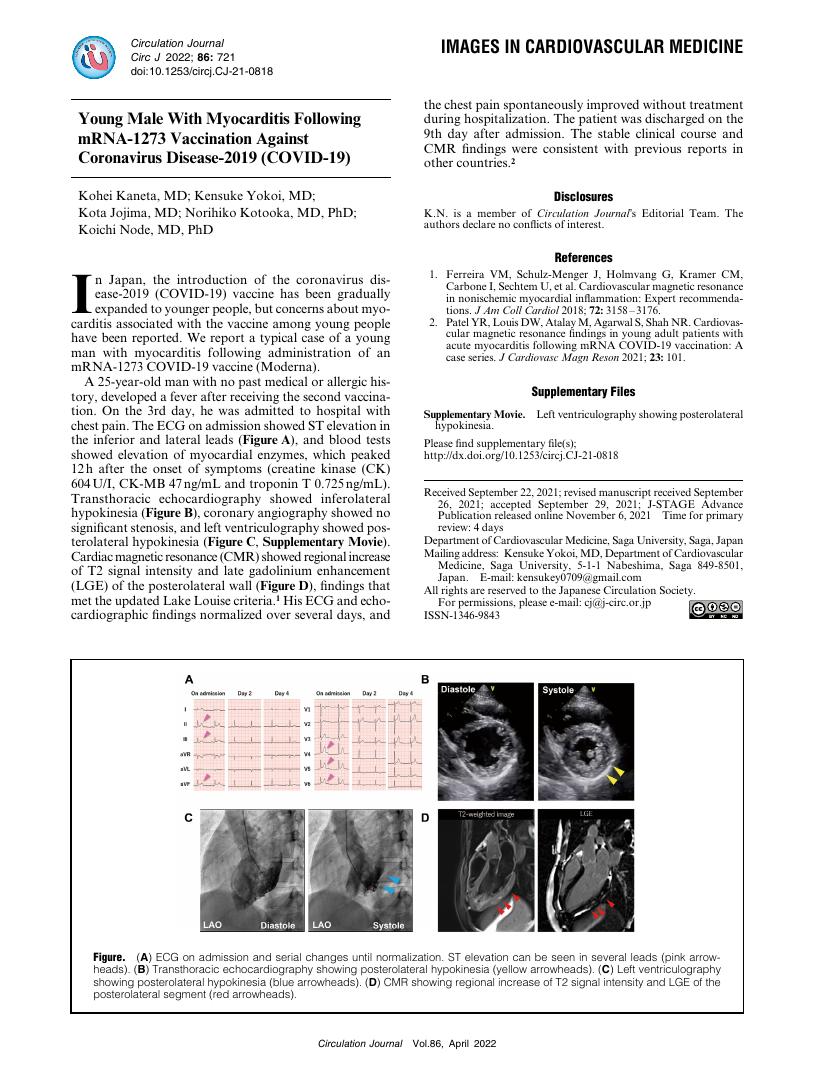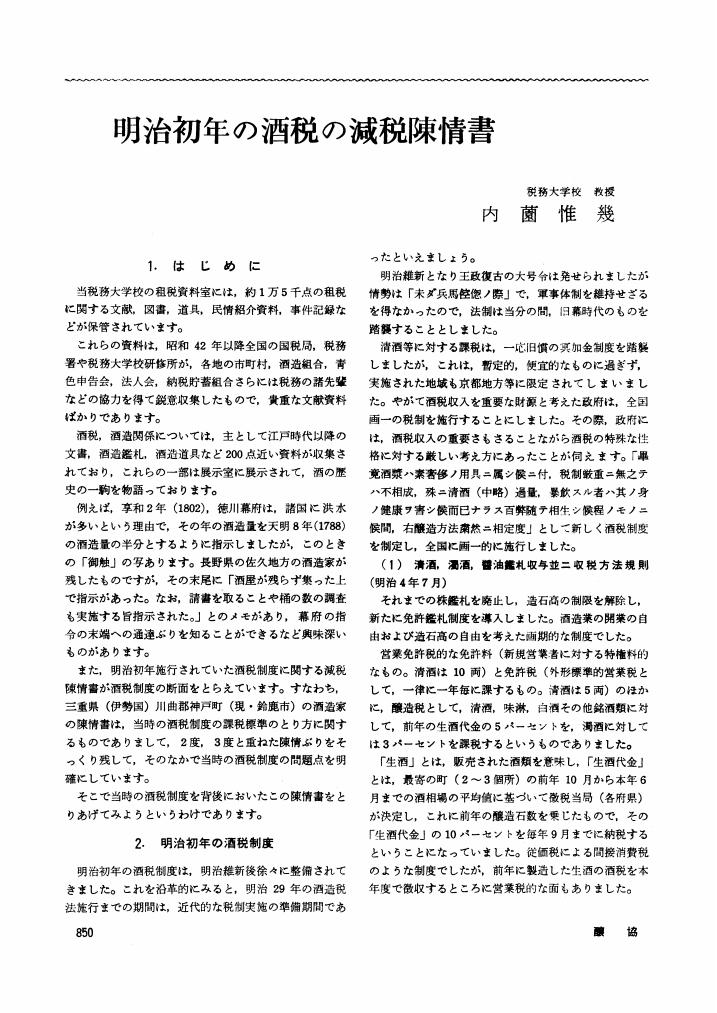13 0 0 0 OA 消費税収の使途に関する議論 : 消費税をめぐる論点(3)
- 著者
- 加藤慶一
- 出版者
- 国立国会図書館
- 雑誌
- 調査と情報 (ISSN:13492098)
- 巻号頁・発行日
- no.753, 2012-05-29
- 著者
- 福島 邦彦
- 出版者
- The Institute of Electronics, Information and Communication Engineers
- 雑誌
- 電子情報通信学会論文誌 A (ISSN:03736091)
- 巻号頁・発行日
- vol.J62-A, no.10, pp.658-665, 1979-10-25
パターン認識における最大の難題は,入力パターンの位置がずれたり形がゆがんだりしたときに,どのような処理を施すべきかという問題であり,この問題に対する根本的な解決法はこれまでみいだされていなかった.筆者は,動物の視覚神経系の構造からヒントを得て,この問題を解決する新しいアルゴリズムを考察し,これを実現する多層の神経回路モデル(ネオコグニトロンと呼ぶ)を構成し,計算機シミュレーションによってその能力を確認したので報告する.この神経回路モデルは,自己組織化能力をも有する.認識すべき複数個のパターンを回路に繰返し呈示しているだけで,回路は,それらのパターンを区別して正しく認識する能力を,教師なし学習によって身につけていく.自己組織化が完了した状態では,回路は,入力パターンの呈示位置がずれても,その大きさや形が多少変形しても,多少の雑音が含まれていても,正しくパターンを認識する.
13 0 0 0 OA Young Male With Myocarditis Following mRNA-1273 Vaccination Against Coronavirus Disease-2019 (COVID-19)
- 著者
- Kohei Kaneta Kensuke Yokoi Kota Jojima Norihiko Kotooka Koichi Node
- 出版者
- The Japanese Circulation Society
- 雑誌
- Circulation Journal (ISSN:13469843)
- 巻号頁・発行日
- vol.86, no.4, pp.721, 2022-03-25 (Released:2022-03-25)
- 参考文献数
- 2
- 被引用文献数
- 1 6
- 著者
- 木本 裕也
- 出版者
- 日本環境動物昆虫学会
- 雑誌
- 環動昆 (ISSN:09154698)
- 巻号頁・発行日
- vol.33, no.1, pp.1-8, 2022-04-25 (Released:2022-05-13)
13 0 0 0 OA 日本大辞書
- 著者
- 山田美妙 (武太郎) 編
- 出版者
- 日本大辞書発行所
- 巻号頁・発行日
- 1893
- 著者
- 越智 萌
- 出版者
- 立命館大学国際関係学会
- 雑誌
- 立命館国際研究 = Ritsumeikan kokusai kenkyu / The Ritsumeikan journal of international studies (ISSN:09152008)
- 巻号頁・発行日
- vol.34, no.1, pp.27-48, 2021-06
13 0 0 0 OA 体操器械之設計 : 体操教授要目所定
13 0 0 0 OA VTOL 実験機とその制御
- 著者
- 丹羽 昌平 杉浦 一郎
- 出版者
- 公益社団法人 計測自動制御学会
- 雑誌
- 計測と制御 (ISSN:04534662)
- 巻号頁・発行日
- vol.25, no.8, pp.729-736, 1986-08-10 (Released:2009-11-26)
- 参考文献数
- 14
13 0 0 0 生産技術
- 著者
- 生産技術協会 [編]
- 出版者
- 生産技術協会
- 巻号頁・発行日
- vol.7(2), no.61, 1952-02
13 0 0 0 OA 内閣法制局による憲法解釈小論
- 著者
- 間柴泰治
- 出版者
- 国立国会図書館
- 雑誌
- レファレンス (ISSN:1349208X)
- 巻号頁・発行日
- no.685, 2008-02
13 0 0 0 OA 熱化学方程式は必要か
- 著者
- 後飯塚 由香里
- 出版者
- 公益社団法人 日本化学会
- 雑誌
- 化学と教育 (ISSN:03862151)
- 巻号頁・発行日
- vol.66, no.9, pp.454-455, 2018-09-20 (Released:2019-09-01)
- 参考文献数
- 14
13 0 0 0 OA 心因性発熱 (機能性高体温症) に対する非薬物療法と薬物療法
- 著者
- 岡 孝和
- 出版者
- 一般社団法人 日本心身医学会
- 雑誌
- 心身医学 (ISSN:03850307)
- 巻号頁・発行日
- vol.60, no.3, pp.234-240, 2020 (Released:2020-04-01)
- 参考文献数
- 7
私の行っている心因性発熱ないし機能性高体温症の治療について概説した. 心因性発熱の治療で重要なのは, 見通しのない経過観察や検査の繰り返し, 解熱薬の投与ではなく, 患者の抱えるストレスに対する個別の処方箋である. そのため単一の治療法では不十分で, 多面的なアプローチが必要となることが多い. 具体的には病態説明, 生活指導, 環境調整, 言語的・非言語的心理療法, 精神生理的技法 (リラクセーショントレーニング), 薬物療法, 併存疾患に対する治療, などを必要に応じて組み合わせて行う. 筆者は, まず患者に対して 「体温が上がると, どのようなことで困るのか」 質問し, 高体温に伴って生じる苦痛を理解するようにしている. さらに, 患者が心因を否認したい場合や, 心因性という病名が患者や患者家族のスティグマとなりそうな場合は, 心因性発熱ではなく, 機能性高体温症という病名を用いて, 病状説明をしている.
- 著者
- Takahiro Nakashima Katsutaka Hashiba Migaku Kikuchi Junichi Yamaguchi Sunao Kojima Hiroyuki Hanada Toshiaki Mano Takeshi Yamamoto Akihito Tanaka Kunihiro Matsuo Naoki Nakayama Osamu Nomura Tetsuya Matoba Yoshio Tahara Hiroshi Nonogi for the Japan Resuscitation Council (JRC) Acute Coronary Syndrome (ACS) Task Force and the Guideline Editorial Committee on behalf of the Japanese Circulation Society (JCS) Emergency and Critical Care Committee
- 出版者
- The Japanese Circulation Society
- 雑誌
- Circulation Reports (ISSN:24340790)
- 巻号頁・発行日
- vol.4, no.5, pp.187-193, 2022-05-10 (Released:2022-05-10)
- 参考文献数
- 30
- 被引用文献数
- 4
Background: To achieve early reperfusion therapy for ST-elevation myocardial infarction (STEMI), proper and prompt patient transportation and activation of the catheterization laboratory are required. We investigated the efficacy of prehospital 12-lead electrocardiogram (ECG) acquisition and destination hospital notification in patients with STEMI.Methods and Results: This is a systematic review of observational studies. We searched the PubMed database from inception to March 2020. Two reviewers independently performed literature selection. The critical outcome was short-term mortality. The important outcome was door-to-balloon (D2B) time. We used the GRADE approach to assess the certainty of the evidence. For the critical outcome, 14 studies with 29,365 patients were included in the meta-analysis. Short-term mortality was significantly lower in the group with prehospital 12-lead ECG acquisition and destination hospital notification than in the control group (odds ratio 0.72; 95% confidence interval [CI] 0.61–0.85; P<0.0001). For the important outcome, 10 studies with 2,947 patients were included in the meta-analysis. D2B time was significantly shorter in the group with prehospital 12-lead ECG acquisition and destination hospital notification than in the control group (mean difference −26.24; 95% CI −33.46, −19.02; P<0.0001).Conclusions: Prehospital 12-lead ECG acquisition and destination hospital notification is associated with lower short-term mortality and shorter D2B time than no ECG acquisition or no notification among patients with suspected STEMI outside of a hospital.
13 0 0 0 OA 財界の名士とはこんなもの?
- 出版者
- 日本電気協会
- 巻号頁・発行日
- no.212, 1939-08
13 0 0 0 OA 明治初年の酒税の減税陳情書
- 著者
- 内薗 惟幾
- 出版者
- 公益財団法人 日本醸造協会
- 雑誌
- 日本釀造協會雜誌 (ISSN:0369416X)
- 巻号頁・発行日
- vol.73, no.11, pp.850-854, 1978-11-15 (Released:2011-11-04)
13 0 0 0 OA 西洋近代が見た日本近世 ― クルトの『SHARAKU』に潜む《暴力》について ―
- 著者
- 岸 文和 Fumikazu Kishi
- 出版者
- 同志社大学人文科学研究所
- 雑誌
- 社会科学 = The Social Science(The Social Sciences) (ISSN:04196759)
- 巻号頁・発行日
- no.68, pp.35-64, 2002-01-31
論説
- 著者
- 稲本 万里子 加藤 拓也 小長谷 明彦
- 出版者
- 一般社団法人 人工知能学会
- 雑誌
- 人工知能学会論文誌 (ISSN:13460714)
- 巻号頁・発行日
- vol.36, no.6, pp.F-L12_1-16, 2021-11-01 (Released:2021-11-01)
- 参考文献数
- 14
”Phantom Genji Scrolls ”are one of the most debatable artifacts whose painter school is still unknown in the history of art. In this study, the authors have reached a conclusion that the Phantom Genji Scrolls would have been painted by the painters who studied Kyoto-Kano and Tosa painter schools but not Edo-Kano painter school.As a learning data set, more than 1500 face images are extracted from well-known the Tale of Genji pictures painted from Heian (12 Century) to Edo (17 Century) periods whose painter schools are all established in the history of art. The face images are written in typical old painting style so called“line-eye and hook nose (hikime-kagihana)” which often represents the characteristics of the painter schools.The authors not only identified the painter school of the Phantom Genji Scrolls but also discovered the inconsistency in Iwasa painter school by means of artifact-based painter school learning model. The t-SNE scatter plots clearly indicated that the 266 face images extracted from the Phantom Genji Scrolls were surrounded by the Kyoto- Kano painter school learning data sets. It should be also noted that the 266 face images were far from the learning data set of Ujinobu Kano, one of the typical Edo-Kano painter. Interestingly, the Phantom Genji Scrolls and Ujinobu Kano were intercepted by Mitsuyoshi Tosa, one of the typical Tosa painter in scatter plot. This suggests that the painters of the Phantom Genji Scrolls may have been affected by both Kyoto-Kano and Tosa painter schools, instead of Edo-Kano painter school.As for the Iwasa painter school, the authors came across strange behavior that the artifacts of Katsutomo Iwasa were identified as the Tosa painter school, even if the validation data of Katsutomo Iwasa were all included in the learning data set of Iwasa painter school, mostly constituted by Katsutomo Iwasa (244 face images). After careful observation and discussion, the authors have concluded that Matabei Iwasa and Kastutomo Iwasa may be too different to be categorized into the same Iwasa painter school with regards to face characteristics.



